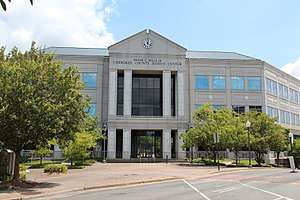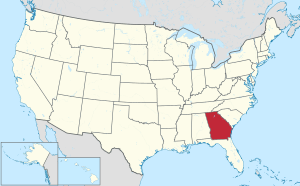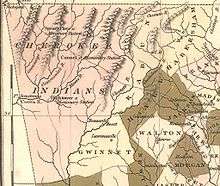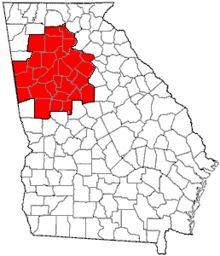Cherokee County, Georgia
Cherokee County is located in the US state of Georgia. As of 2019 estimates, the population was 258,773.[1] The county seat is Canton, population 29,306 (2018).[2] The county Board of Commissioners is the governing body, with members elected to office.
Cherokee County | |
|---|---|
 Cherokee County Justice Center | |
 Location within the U.S. state of Georgia | |
 Georgia's location within the U.S. | |
| Coordinates: 34°14′N 84°28′W | |
| Country | |
| State | |
| Founded | 1831 |
| Named for | Cherokee people |
| Seat | Canton |
| Largest city | Woodstock |
| Area | |
| • Total | 434 sq mi (1,120 km2) |
| • Land | 421 sq mi (1,090 km2) |
| • Water | 13 sq mi (30 km2) 2.9%% |
| Population | |
| • Estimate (2019) | 258,773 |
| • Density | 586/sq mi (226/km2) |
| Time zone | UTC−5 (Eastern) |
| • Summer (DST) | UTC−4 (EDT) |
| Congressional district | 11th |
| Website | www |
Cherokee County is included in the Atlanta-Sandy Springs-Roswell, Georgia metropolitan statistical area.
History
Original territory

Originally, Cherokee County was more like a territory than a county, covering lands northwest of the Chattahoochee River and Chestatee River except for Carroll County. This county was created December 26, 1831, by the state legislature. It was named after the Cherokee Indians who lived in the area at that time.[3] Several other counties were carved out of these Cherokee lands as part of the Cherokee Land Lottery of 1832.[4]

An act of the Georgia General Assembly passed on December 3 of that year created the counties of Forsyth, Lumpkin, Union, Cobb, Gilmer, Murray, Cass (now Bartow), Floyd, and Paulding.[5] The forcible (sometimes at gunpoint) removal of the Cherokee people, leading up to the notorious Trail of Tears to Indian Territory west of the Mississippi River, began in this area the year before. The push by European Americans to expel the Cherokee was accelerated by the discovery of gold in local streams.
County courts were authorized to meet at the home of Ambrose Harnage. The settlement soon became known as Harnageville, later called Marble Works, and even later Tate, when Cherokee County was first established. Since 1880, that town has been called Tate, and it is now (since 1853) in Pickens County. Part of that county was taken directly from Cherokee, the other via Gilmer County (itself earlier taken from Cherokee).
Etowah was named the first county seat in 1833. Its name was later changed to Canton.
Remaining county
In 1857, part of the southeastern corner of the county was ceded by the General Assembly to form Milton County (now the city of Milton in the county of Fulton). In the 1890s, The Atlanta & Knoxville Railroad (later renamed the Marietta & North Georgia Railroad when it could not be completed to Knoxville) built a branch line through the middle of the county. When this line was bought by the Louisville & Nashville Railroad the following decade, the L&N built railroad stations at Woodstock and other towns.
Development
Since the late 20th century, Cherokee County has been part of the Atlanta metro area. It is bisected by Interstate 575, which runs from Marietta north through Woodstock, Lebanon, Holly Springs, Canton, and Ball Ground, ending at the Pickens County line into Georgia 515, the Appalachian Parkway developmental highway. Interstate 575 is undergoing significant widening to accommodate growth in Cherokee County population.
The Georgia Northeastern Railroad operates freight service on the former L&N tracks, roughly parallel to this route. Population growth has followed the same general pattern, as well, with new suburbs in the south following the highway toward exurbs further north.
Geography
According to the U.S. Census Bureau, the county has a total area of 434 square miles (1,120 km2), of which 422 square miles (1,090 km2) are land and 13 square miles (34 km2) (2.9%) are covered by water.[6] Much of the water is in Lake Allatoona in the southwest. The lake is fed by the Etowah and Little Rivers (the county's primary waterways), and other large streams such as Noonday Creek. Much of the northern part of the county begins to rise toward the foothills.
The vast majority of Cherokee County is located in the [Etowah River] subbasin of the Coosa-Tallapoosa River Basin, with only a small northwesterly corner of the county located in the Coosawattee River subbasin of the same basin.[7]
Mountains

Nine summits are listed by the United States Geological Survey Geographic Names Information System as being in the county. From tallest to lowest, they are:
- Bear Mountain – 2,297 feet (700 m)
- Pine Log Mountain – 2,260 feet (689 m)
- Oakey Mountain – 1,686 feet (514 m)
- Dry Pond Mountain – 1,644 feet (501 m)
- Hickory Log Mountain – 1,545 feet (471 m)
- Polecat Mountain – 1,503 feet (458 m)
- Byrd Mountain – 1,358 feet (414 m)
- Garland Mountain – 1,348 feet (411 m)
- Posey Mountain – 1,306 feet (398 m)
These mountains are in the still-rural northern and western parts of the county. However, if considered part of metro Atlanta, Bear Mountain is the tallest in the metro area.
Government, politics, and policing
Government
The five-member board of commissioners is elected from four districts, with an at-large county commission chair. Thus, members are elected as residents of geographic districts, but the commission chair must receive the majority vote of the county in total. Each is elected to a four-year term.
Cherokee County sheriff and municipal police
The county is under the jurisdiction of the Cherokee County Sheriff's Office, which is headed by Sheriff Frank Reynolds. The Cherokee County Sheriff's office is accredited by CALEA. The major cities within the county have individual municipal police departments, such as Woodstock, Canton, Holly Springs, and Ball Ground.
Politics
Cherokee County had voting patterns similar to most Solid South and Georgia counties prior to 1964 in presidential elections, though Democratic Party candidates did not win by as wide margins as they did in the rest of the state and the Deep South. In fact, the county backed Republican candidates three times between 1900 and 1960. From 1964 on, the county has swung strongly toward the Republicans, only failing to vote for the Republican in presidential elections since then in 1968 when segregationist George Wallace appealed to anti-Civil Rights Act sentiment and in the two elections Georgian Jimmy Carter was on the ballot. In addition, unlike the inner suburban counties of the Atlanta metropolitan area, Cherokee County has continued to vote for Republicans by landslide margins as it lacks the increasing number of minority voters those counties have gained in recent years.
| Year | Republican | Democratic | Third Parties |
|---|---|---|---|
| 2016 | 71.5% 80,649 | 22.4% 25,231 | 6.1% 6,904 |
| 2012 | 77.7% 76,514 | 20.2% 19,841 | 2.1% 2,084 |
| 2008 | 74.8% 70,279 | 23.8% 22,350 | 1.4% 1,344 |
| 2004 | 79.0% 58,238 | 20.1% 14,824 | 0.9% 665 |
| 2000 | 72.7% 38,033 | 23.5% 12,295 | 3.9% 2,020 |
| 1996 | 63.4% 24,527 | 27.9% 10,802 | 8.7% 3,348 |
| 1992 | 55.0% 16,054 | 27.8% 8,113 | 17.3% 5,047 |
| 1988 | 76.5% 14,593 | 22.9% 4,378 | 0.6% 117 |
| 1984 | 76.1% 11,146 | 23.9% 3,499 | |
| 1980 | 45.0% 5,250 | 51.6% 6,020 | 3.5% 408 |
| 1976 | 28.5% 2,609 | 71.5% 6,539 | |
| 1972 | 82.6% 5,509 | 17.4% 1,159 | |
| 1968 | 35.9% 2,675 | 19.3% 1436 | 44.9% 3,351 |
| 1964 | 51.6% 3,398 | 48.4% 3,189 | |
| 1960 | 43.2% 2,341 | 56.8% 3,077 | |
| 1956 | 46.4% 1,829 | 53.6% 2,110 | |
| 1952 | 39.8% 1,618 | 60.3% 2,452 | |
| 1948 | 11.6% 250 | 58.9% 1,267 | 29.5% 636 |
| 1944 | 44.0% 1,059 | 56.0% 1,348 | |
| 1940 | 39.4% 1,017 | 60.1% 1,552 | 0.5% 13 |
| 1936 | 40.9% 842 | 58.8% 1,211 | 0.3% 7 |
| 1932 | 15.3% 314 | 83.9% 1,727 | 0.9% 18 |
| 1928 | 74.3% 1,679 | 25.7% 581 | |
| 1924 | 40.0% 601 | 56.4% 848 | 3.6% 54 |
| 1920 | 67.7% 1,138 | 32.3% 544 | |
| 1916 | 28.7% 461 | 53.2% 855 | 18.2% 292 |
| 1912 | 53.2% 710 | 45.2% 603 | 1.6% 21 |
Demographics
| Historical population | |||
|---|---|---|---|
| Census | Pop. | %± | |
| 1840 | 5,895 | — | |
| 1850 | 12,800 | 117.1% | |
| 1860 | 11,291 | −11.8% | |
| 1870 | 10,399 | −7.9% | |
| 1880 | 14,325 | 37.8% | |
| 1890 | 15,412 | 7.6% | |
| 1900 | 15,243 | −1.1% | |
| 1910 | 16,661 | 9.3% | |
| 1920 | 18,569 | 11.5% | |
| 1930 | 20,003 | 7.7% | |
| 1940 | 20,126 | 0.6% | |
| 1950 | 20,750 | 3.1% | |
| 1960 | 23,001 | 10.8% | |
| 1970 | 31,059 | 35.0% | |
| 1980 | 51,699 | 66.5% | |
| 1990 | 90,204 | 74.5% | |
| 2000 | 141,903 | 57.3% | |
| 2010 | 214,346 | 51.1% | |
| Est. 2019 | 258,773 | [9] | 20.7% |
| U.S. Decennial Census[10] 1790–1960[11] 1900–1990[12] 1990–2000[13] 2010–2019[1] | |||
2010 census
As of the 2010 United States Census, 214,346 people, 75,936 households, and 57,876 families were living in the county.[14] The population density was 508.3 inhabitants per square mile (196.3/km2). The 82,360 housing units averaged 195.3 per square mile (75.4/km2).[15] The racial makeup of the county was 86.6% White, 5.65% Black or African American, 1.65% Asian, 0.4% American Indian, 0.1% Pacific Islander, 3.6% from other races, and 2.1% from two or more races. Those of Hispanic or Latino origin of any race made up 9.6% of the population.[14] In terms of ancestry, 16.2% were Irish, 16.1% were German, 14.1% were English, 10.7% were American, and 5.7% were Italian.[16]
Of the 75,936 households, 41.4% had children under the age of 18 living with them, 61.9% were married couples living together, 10.1% had a female householder with no husband present, 23.8% were not families, and 18.8% of all households were made up of individuals. The average household size was 2.80 and the average family size was 3.20. The median age was 36.3 years.[14]
The median income for a household in the county was $66,320 and for a family was $77,190. Males had a median income of $53,773 versus $40,153 for females. The per capita income for the county was $30,217. About 5.5% of families and 7.4% of the population were below the poverty line, including 8.4% of those under age 18 and 7.7% of those age 65 or over.[17]
2000 census
As of the census[18] of 2000, 141,903 people, 49,495 households, and 39,200 families resided in the county. The population density was 335 people per square mile (129/km²).
Of the 49,495 households, 41.40% had children under the age of 18 living with them, 67.20% were married couples living together, 8.30% had a female householder with no husband present, and 20.80% were not families. About 16.00% of all households were made up of individuals, and 4.10% had someone living alone who was 65 years of age or older. The average household size was 2.85 and the average family size was 3.18.
In the county, the population was distributed as 28.30% under the age of 18, 7.70% from 18 to 24, 35.80% from 25 to 44, 21.70% from 45 to 64, and 6.60% who were 65 years of age or older. The median age was 34 years. For every 100 females, there were 100.70 males. For every 100 females age 18 and over, there were 98.90 males.
The median income for a household in the county was $60,896, and for a family was $66,419. Males had a median income of $44,374 versus $31,036 for females. The per capita income for the county was $24,871. About 3.50% of families and 5.30% of the population were below the poverty line, including 5.50% of those under age 18 and 9.80% of those age 65 or over.
Fastest-growing county
According to the local newspaper, the Cherokee Ledger-News, on August 29, 2018, with an estimated population of 254,500, Cherokee is currently the fastest-growing county in the metro Atlanta area.[19]
Education
Public schools
- Cherokee County School District (40 Schools)
- Cherokee Charter Academy (CSUSA)
Private schools
Private schools in Cherokee County include:
- Lyndon Academy (Woodstock)
- Cherokee Christian Schools (Woodstock)
- Cherokee Christian Academy (Woodstock)
- Community Christian School (Canton)
- Crossroads Christian School (Canton)
- Omega Learning Academy (Woodstock)
- The King's Academy (Woodstock)
Higher education
- Reinhardt University is a private, co-educational liberal arts college located in Waleska, Georgia.
Chattahoochee Technical College has campuses in Woodstock and Canton in Cherokee County.
Transportation
Major highways













Airport
The Cherokee County Airport (FAA LOC ID: CNI) is located adjacent to I-575 about six miles (10 km) northeast of downtown Canton.
A redevelopment project recently completed a 10,000-square-foot (930 m2) terminal, the lengthening of the runway from 3,414 to 5,000 feet (1,041 to 1,524 m), a new parallel taxiway, instrument landing equipment, and new hangars. The new facilities will accommodate 200 corporate aircraft in hangars and provide 100 tie-downs for smaller aircraft.
Public transportation
The Cherokee Area Transit Service serves all of the Cherokee County area, rural and suburban.
Pedestrians and cycling
- Noonday Creek Trail
- Serenade Trail
- Trestle Rock Trail
Communities
Unincorporated communities
- Avery
- Batesville
- Buffington
- Burris Crossroads
- Creighton
- Free Home
- Gober
- Gold Ridge
- Hickory Flat
- Holbrook
- Keithsburg
- Lake Arrowhead
- Lathemtown
- Lebanon
- Toonigh (neighborhood of Holly Springs)
- Macedonia
- Mica
- Oak Grove
- Ophir
- Orange
- Salacoa
- Sixes
- Sutallee
- Towne Lake
- Union Hill
- Univeter
- Victoria
Notable residents
- Joseph E. Brown was elected governor of Georgia in 1857 and later served as U.S. Senator from Georgia. Brown's primary residence and law practice were in Canton, and he owned a farm believed to be near the Sutallee community.
- Ira Roe Foster was Quartermaster General of Georgia, a brigadier general in the Georgia Militia (1845), attorney, medical doctor, Cherokee County State Representative, first mayor of Eastman, Georgia, and Alabama state senator.
- Josh Holloway, actor and model, is most famous for his role as James "Sawyer" Ford on Lost. He attended Free Home Elementary in Free Home and Cherokee High School in Canton.
- Johnny Hunt was president of the Southern Baptist Convention in 2008–2010.
- Chris Kirk, a PGA Tour golfer, attended Etowah High School.
- Nick Markakis, MLB outfielder for the Atlanta Braves, attended Woodstock High School.
- Bruce Miller, NFL fullback, formerly played for the San Francisco 49ers, attended Woodstock High School.
- Robert Rechsteiner, better known as Rick Steiner, ex-professional wrestler, is now a part of the school board for the county. He also sells homes in the county as a real estate agent.
- Blair Redford, an actor best known for his roles as Scotty Grainger on The Young and the Restless and Miguel Lopez-Fitzgerald on Passions, grew up in Canton.
- Dean Rusk, U.S. Secretary of State, was born in Cherokee County.
- Buster Skrine, NFL cornerback for the New York Jets, attended Etowah High School.
References
- "2019 County Metro Population Estimates". United States Census Bureau. Retrieved March 26, 2020.
- "Find a County". National Association of Counties. Archived from the original on May 3, 2015. Retrieved June 7, 2011.
- Krakow, Kenneth K. (1975). Georgia Place-Names: Their History and Origins (PDF). Macon, GA: Winship Press. p. 41. ISBN 0-915430-00-2.
- "GeorgiaInfo has moved :: Carl Vinson Institute of Government". Cviog.uga.edu. Archived from the original on May 11, 2008. Retrieved July 22, 2010.
- "GeorgiaInfo has moved :: Carl Vinson Institute of Government". Cviog.uga.edu. Archived from the original on February 18, 2008. Retrieved July 22, 2010.
- "US Gazetteer files: 2010, 2000, and 1990". United States Census Bureau. February 12, 2011. Retrieved April 23, 2011.
- "Georgia Soil and Water Conservation Commission Interactive Mapping Experience". Georgia Soil and Water Conservation Commission. Retrieved November 19, 2015.
- Leip, David. "Dave Leip's Atlas of U.S. Presidential Elections". uselectionatlas.org. Retrieved March 19, 2018.
- "Population and Housing Unit Estimates". Retrieved March 26, 2020.
- "U.S. Decennial Census". United States Census Bureau. Retrieved June 17, 2014.
- "Historical Census Browser". University of Virginia Library. Retrieved June 19, 2014.
- "Population of Counties by Decennial Census: 1900 to 1990". United States Census Bureau. Retrieved June 19, 2014.
- "Census 2000 PHC-T-4. Ranking Tables for Counties: 1990 and 2000" (PDF). United States Census Bureau. Retrieved June 19, 2014.
- "DP-1 Profile of General Population and Housing Characteristics: 2010 Demographic Profile Data". United States Census Bureau. Archived from the original on February 13, 2020. Retrieved December 27, 2015.
- "Population, Housing Units, Area, and Density: 2010 – County". United States Census Bureau. Archived from the original on February 13, 2020. Retrieved December 27, 2015.
- "DP02 SELECTED SOCIAL CHARACTERISTICS IN THE UNITED STATES – 2006–2010 American Community Survey 5-Year Estimates". United States Census Bureau. Archived from the original on February 13, 2020. Retrieved December 27, 2015.
- "DP03 SELECTED ECONOMIC CHARACTERISTICS – 2006–2010 American Community Survey 5-Year Estimates". United States Census Bureau. Archived from the original on February 13, 2020. Retrieved December 27, 2015.
- "U.S. Census website". United States Census Bureau. Retrieved May 14, 2011.
- Hartwell, Thomas (August 29, 2018). "ARC: Cherokee fastest growing county in metro Atlanta area". The Cherokee Ledger-News.

